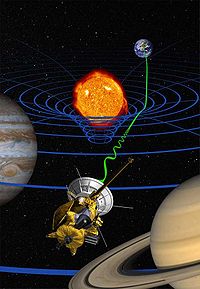
Photo from wikipedia
The local position invariance principle of general relativity stipulates that non-gravitational experiments should give outcomes that are independent of the position and orientation of the reference frames in which they… Click to show full abstract
The local position invariance principle of general relativity stipulates that non-gravitational experiments should give outcomes that are independent of the position and orientation of the reference frames in which they have been performed. Here, we study the change in the rates of clocks on Earth with the spatial change of the solar potential, constraining the variation of a non-gravitational interaction—the hyperfine splitting in hydrogen and caesium atoms—to β = (2.2 ± 2.5) × 10−7, a factor of two improvement over previous estimates. Our result is based on the comparison between the long-term fractional frequency variation of four hydrogen masers that are part of an ensemble of clocks comprising the National Institute of Standards and Technology, Boulder, and the fractional frequencies of primary frequency standards operated by leading metrology laboratories in the United States, France, Germany, Italy and the United Kingdom over a period of more than 14 years. Using our results together with the previous best estimates of β, we impose strict limits on the variation of fundamental constants, resulting in a test of general relativity with an unprecedented level of precision.Years of data from atomic clocks around the world allow estimation of the variation of their rates with the spatial change of the solar potential. This allows the most precise null test of the local position invariance principle of general relativity.
Journal Title: Nature Physics
Year Published: 2018
Link to full text (if available)
Share on Social Media: Sign Up to like & get
recommendations!